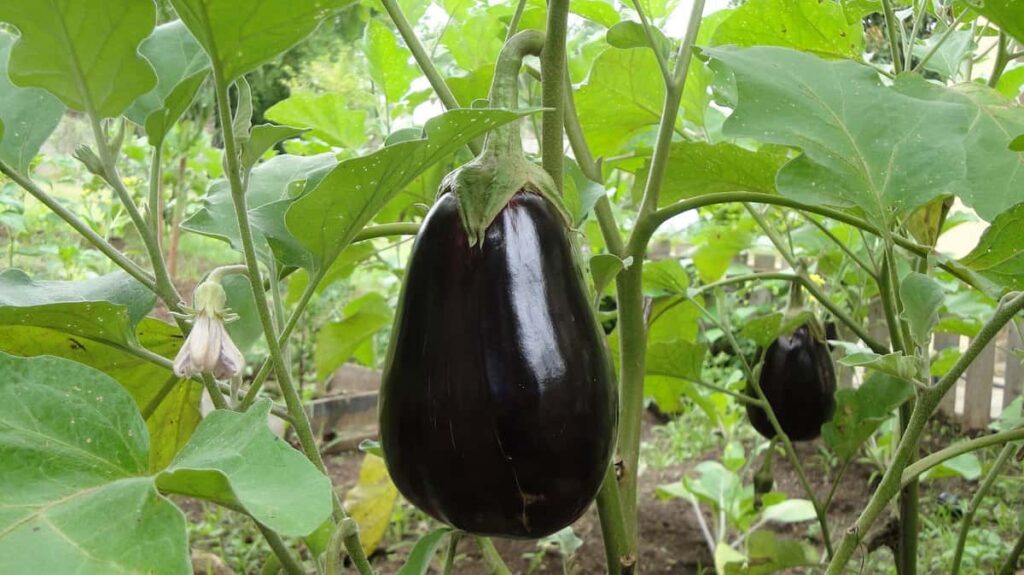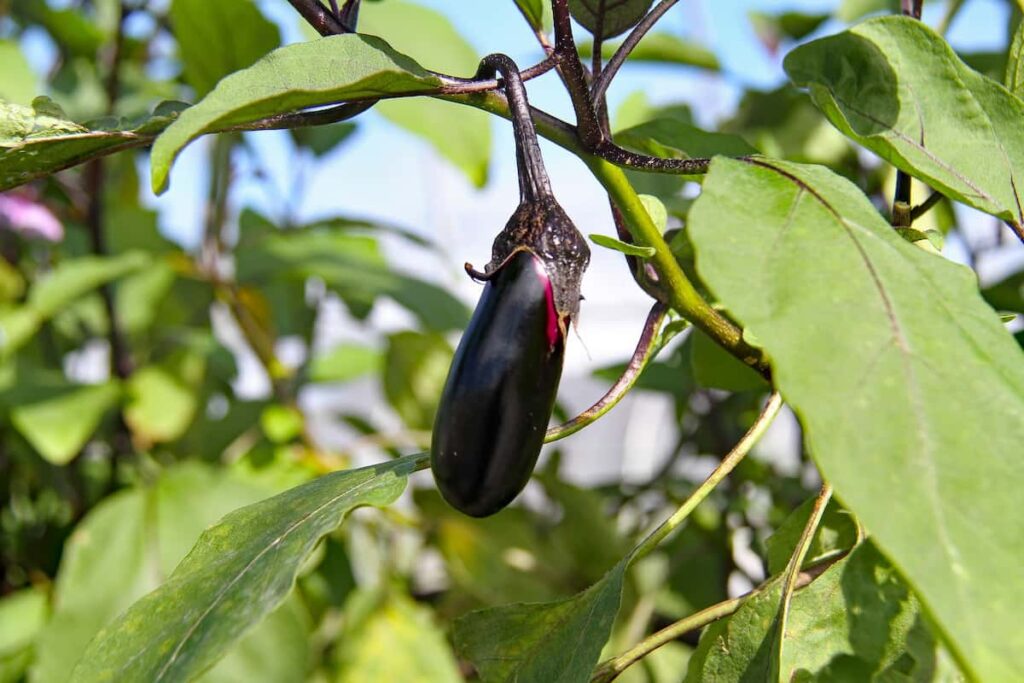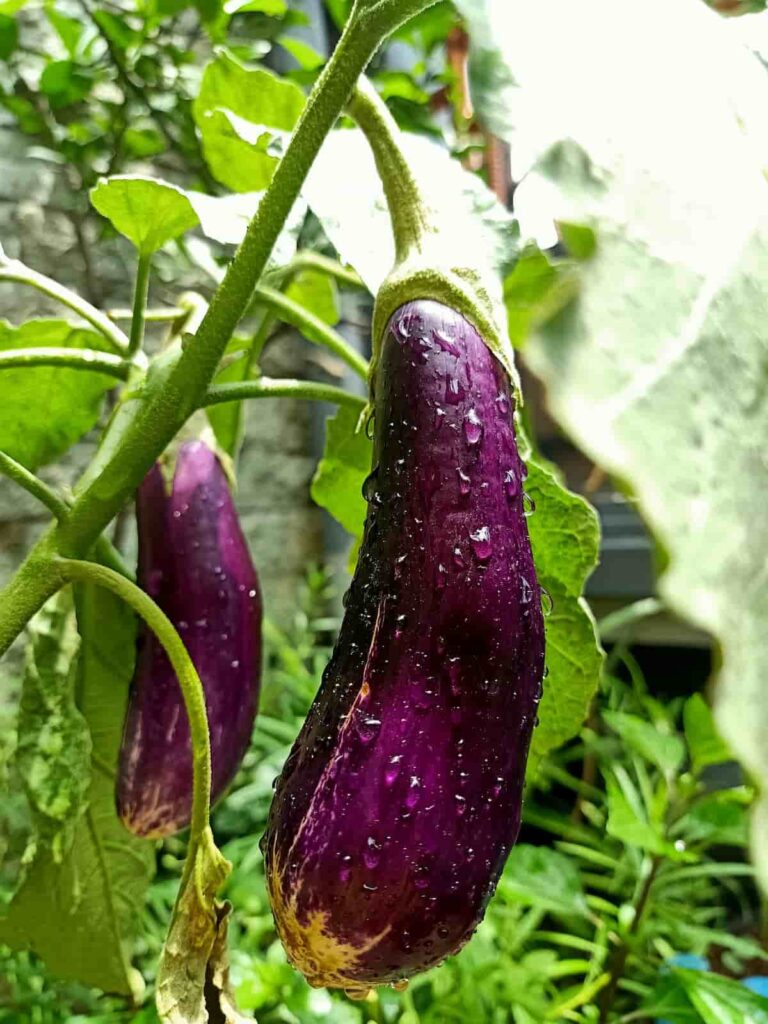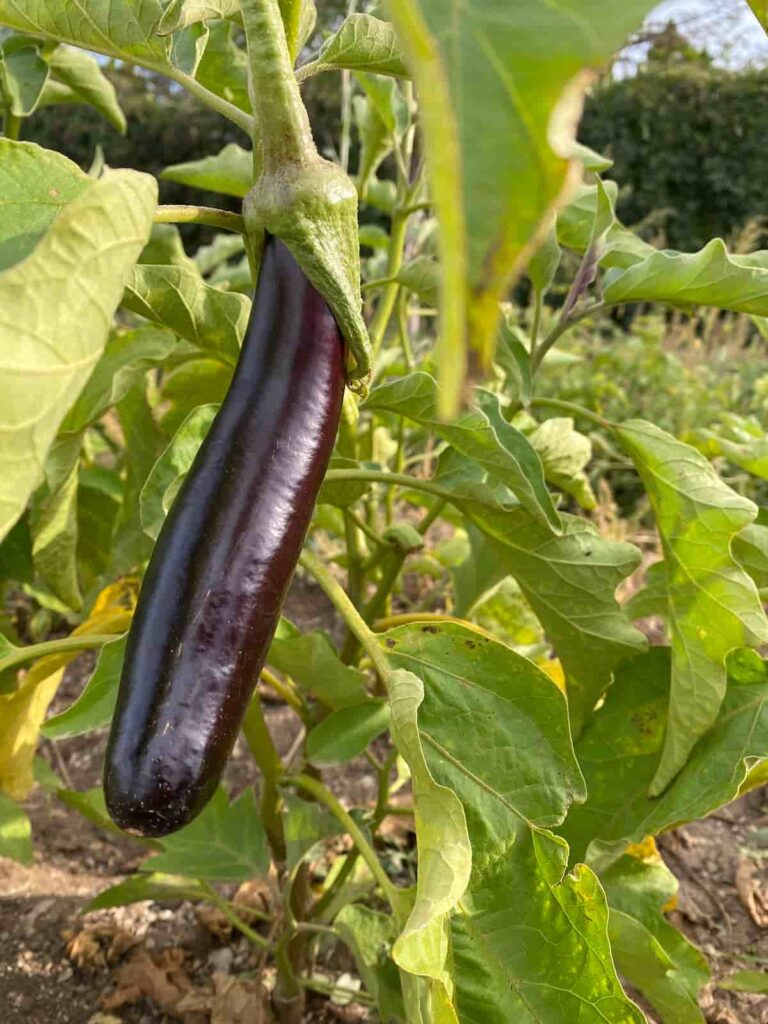Eggplant is a popular vegetable in many cuisines. It’s also known as aubergine or brinjal. Eggplant is a nightshade family member, including Bell Peppers, Tomatoes, and Potatoes. Eggplant is a versatile and delicious vegetable used in various dishes. It’s also relatively easy to grow, making it a great choice for beginner and experienced gardeners. If you’re interested in growing Eggplant in the United States, you should know a few things.

How to grow Eggplant in USA
Soil requirement for growing Eggplant in the USA
Eggplant is a heat-loving vegetable that grows best in sandy loam soils with a pH of 6.0 to 7.0. The soil must be well-drained and high in organic matter. To improve drainage, add 2 to 4 inches of organic matter, such as compost or manure, to the planting bed before planting. Eggplants require full sun to produce high yields of quality fruits.
Provide shading for the plants during the hot summers. Eggplant is a heat-loving annual vegetable that grows best in full sun. The soil should be well-drained and rich in organic matter. Eggplants can be started from seed or transplanted from nursery stock.
Eggplant varieties in the USA
Many different types of Eggplant can be grown in the USA. They come in different colors, shapes, and sizes. Some common varieties include:
Black Beauty
This is the most popular type of Eggplant in the USA. It has dark purple skin and is oval. This is a classic Eggplant variety grown in the USA for many years. It is a large, glossy, purple-black Eggplant with smooth skin. The flesh is firm and white with a mild flavor. Black Beauty Eggplants are best harvested when they are about 8 inches long.
Italian Eggplant
This variety is long and thin, with a deep purple color. It is often used in Italian dishes. This variety is slightly smaller than Black Beauty but has a more elongated shape. Italian Eggplants have a deep purple color and a milder flavor than other varieties. They are often used in Mediterranean cuisine.
In case you missed it: Brinjal Farming Profit, Cost, Yield, Income (Eggplant)

Japanese Eggplant
This Eggplant is long and slender, with a deep purple color. It is often used in Japanese dishes. This variety is smaller and narrower than Black Beauty, with dark purple or black skin. The flesh is tender and white with a slightly sweet flavor. Japanese Eggplants are best harvested when they are about 6 inches long.
White Eggplant
This variety has white or pale yellow skin and is round or oval. It has a milder flavor than other varieties.
Fairy Tale Eggplant
This variety is small and round, with pale lavender or white skin. The flesh is delicate and mild-flavored. Fairy Tale Eggplants are best harvested at about 2 inches in diameter. Many other Eggplant varieties can be cultivated in the USA, including White Eggplant, Green Eggplant, Thai Eggplant, Baby Eggplant, and more.
Eggplant growing conditions in the USA
- Eggplants are heat-loving plants that require a long, warm growing season to produce fruits.
- Eggplants prefer rich, well-drained soils with a pH between 6.0 and 7.0. They should be fertilized regularly with a balanced fertilizer to encourage growth and fruit production.
- For best results, fertilize your Eggplants regularly throughout their growing season. An all-purpose fertilizer should work well. Apply it according to package directions, and be sure not to overdo it, as too much fertilizer can cause leaf burn.
- Eggplant should be watered deeply and regularly during growth to keep the soil evenly moist but not soggy. Mulching around plants will help conserve moisture and control weeds.
- Water Eggplants regularly apply 1-2 inches of water per week through rainfall or irrigation, especially during drought. Mulch around plants to help conserve moisture and suppress weeds.
- Eggplants are best suited for growing in warm climates with long summers. In the United States, they are typically planted in early summer or late spring.
- Eggplants need full sun to produce well, so choose a planting location with 6 hours of direct sunlight daily. The soil should be well-drained and rich in organic matter. If the soil is heavy clay or sandy, mix in some compost or other organic matter to improve its structure.
- Harvest Eggplants when they are glossy and deep purple. Cut off the fruit with a sharp knife, leaving a short stem attached.
Eggplant growing areas in the USA
Eggplant is a tropical plant typically grown as a summer annual in the United States. Eggplant is grown in warm climates worldwide, including the southern and eastern United States. New Jersey stands ahead of leading producers like California and New York. Florida, Arizona, and Georgia.
In case you missed it: Brinjal Pests and Diseases (Eggplant), Symptoms, Control

Growing Eggplant in pots
- Growing Eggplant in pots is a great way to enjoy this delicious vegetable without taking up too much space. Eggplants are relatively easy to grow vegetables and can be started from seed, but they require some care and attention.
- Eggplants need full sun and well-drained soil. If you start with seedlings, harden them before planting by gradually exposing them to outdoor conditions.
- Plant Eggplants about 12 inches apart in a large pot or container. Be sure to water regularly, as Eggplants require consistent moisture.
- Apply a fertilizer high in nitrogen when the plants are about 6 inches tall and then again when the fruits start to form.
- To encourage fruit production, pinch off the tips of the plants when they reach 18 inches tall. This will cause the plant to branch out and produce more flowers and fruits.
- Harvest Eggplants when they are glossy and firm, typically around 80 days after planting.
Growing Eggplant from seed in the USA
- Start your seeds indoors for about 6 to 8 weeks in the USA before the last frost date in your area. Eggplant seeds need warm temperatures to germinate, so it’s best to start them indoors where you can control the temperature.
- Plant your seeds in a sterile potting mix and water them well. Keep the soil moist but not soggy.
- When your seedlings are about 4 inches tall, transplant them into larger pots or your garden bed. Be sure to harden off your seedlings gradually before planting them outdoors.
- Eggplants need full sun and well-drained soil to thrive. Amend your soil by using compost or other organic matter before planting.
- Water your Eggplants regularly, especially during hot, dry weather. Mulch around your plants to help retain moisture in the soil.
- Fertilize your plants with a balanced fertilizer or compost tea every few weeks.
- Harvest your Eggplants when they’re glossy and deep purple. Cut them from the plant using a sharp knife, careful not to damage the stem.
How long do Eggplant plants live?
Eggplants are annual plants that complete their life cycle in one planting season. In areas with long growing seasons, Eggplants can be planted as early as March and harvested as late as November. In most areas of the USA, however, the best time to plant Eggplant is late May or early June. This allows the plants enough time to mature the fruit before the first frost of winter.
Eggplant plants typically live for about four months. This includes the time it takes to grow from seedlings to mature plants and flowers and produce fruit. Once the fruits are harvested, the plant will die back and eventually turn completely brown and dry up.
In case you missed it: Brinjal Seed Germination (Eggplant) Procedure

How to grow Eggplant vertically?
Growing Eggplant vertically is a great method if you live in a limited space or have poor soil. All you need is a support system and some basic materials.
- A support system – This can be a trellis, tomato cage, or even a simple stake. Make sure whatever you use is sturdy and can support the weight of the plants as they grow.
- Eggplant seeds or seedlings – You can find these at your local nursery or online.
- Soil mix – Choose a high-quality mix that drains well. Eggplants don’t like to sit in wet soil.
- Fertilizer – A good organic fertilizer will do the trick.
Now that you have everything you need, let’s get started;
- Choose a location for your plants. Eggplants need full sun to produce lots of fruits, so pick a spot that gets at least 8 hours of sun per day. If using a trellis or tomato cage, ensure it’s in place before planting.
- Prepare the soil mix according to package directions and plant your seeds or seedlings about 18 inches apart. Firm the soil around each plant to help support it as it grows.
- Water regularly, making sure to keep the soil moist.
Grow Eggplant in a greenhouse
- A greenhouse is an ideal place to grow Eggplant because it provides the warm temperatures and protection from harsh weather that the plants need.
- The first step is to choose a suitable location for your greenhouse. It should be in an area with plenty of sunlight and good drainage.
- Prepare the soil by adding organic matter like compost or manure. Eggplants need fertile, well-drained soil to thrive.
- Start your plants with seedlings or transplants. Set the plants out in the greenhouse after all danger of frost has passed.
- Water regularly, especially during dry spells. Eggplants are susceptible to drought stress, so ensure they always have enough moisture.
- Mulch around the plants to help keep the soil moist. Black plastic mulch is particularly effective at reflecting heat and keeping the roots cool.
- Monitor for pests and diseases and take action if necessary. Common problems include aphids, whiteflies, and fungal diseases such as powdery mildew or Verticillium wilt.
In case you missed it: Mulching Brinjal Plants (Eggplants) Organically/Inorganically
Grow Eggplant in Florida
If you’re thinking of adding Eggplant to your garden, you’ll be happy to know that this delicious vegetable is relatively easy to grow. Eggplant grows best in warm weather, so if you live in a place with a long growing season, such as Florida, you should have no problem getting your Eggplant plants to produce a good crop. In most of Florida, Eggplant can be grown successfully in warm and cool seasons.
Raised beds, mulching, and drip irrigation are appropriate growing techniques for this vegetable. Eggplant prefers evenly moist soil but usually requires less water than tomatoes. Start Eggplant in your garden in North Florida between February and March or August. Central Florida gardens start between January and February or August and September. In South Florida, Eggplant can be successfully started anytime between August and February.
It is usually grown only in the cool season in this region. These planting dates are essential. The fruits taste bitter if the weather is too hot or dry. Eggplant is a popular vegetable crop in the United States. It is a warm-season crop that is typically started from transplants.
Growing Eggplant in Arizona
Eggplants are a popular vegetable in many cuisines and are easy to grow in Arizona. To grow Eggplant in Arizona, start by selecting a sunny spot in your garden. Eggplants need at least 6 hours of sunlight each day to produce fruits. The soil should be well-drained and rich in organic matter. Eggplants are heavy feeders, so amend the soil with compost or manure before planting.
Eggplant growing problems
- Poor drainage causes the plant to become waterlogged and rot.
- Lack of nutrients in the soil results in stunted growth and yellowing leaves.
- Pests and diseases such as aphids, whiteflies, and fungal infections can attack the plant and reduce yields.
- Extreme temperatures can cause the flowers to drop or the fruit to turn bitter.
- Poor pollination leads to misshapen fruit.
To avoid these problems, it is essential to choose a suitable site for planting, provide adequate drainage, fertilize regularly, and protect the plants from pests and diseases. Additionally, Eggplants should be harvested when ripe to ensure the best flavor.
Eggplant pests, diseases, and their control tips in the USA
- Eggplant is susceptible to several insect pests and diseases, so it is essential to monitor plants closely and take preventive measures. Common insect pests include aphids, whiteflies, spider mites, flea beetles, and cucumber beetles.
- Eggplant pests and diseases are common problems for farmers in the United States. The most common pests include cucumber beetles, flea beetles, whiteflies, and aphids. The most common diseases include Verticillium wilt, Fusarium wilt, and Alternaria leaf spot.
- There are a few things that farmers can do to control these pests and diseases. One way is to use row covers or screens to prevent pests from getting to the plants. Another way is to use traps or bait to catch or kill the pests. Farmers can also use chemicals to control pests and diseases, but this should be done as a last resort.
- Eggplant is susceptible to garden pests: aphids, beetles (commonly flea beetles), caterpillars, thrips, etc. Spider mites and leaf miners can cause severe damage to young plants. Practice proactive Integrated Pest Management for a good harvest. Eggplant is vulnerable to several bacterial, fungal, and viral diseases. Cultural practices such as crop rotation, cleaning tools, and irrigating appropriately usually prevent these issues from becoming severe in-home gardens.
- Water is at the plant base, not on the leaves. Therefore, apply a layer of mulch around the plants to conserve moisture and control weeds.
- To prevent problems, start with healthy plants and water them regularly (but do not overwater).
- Watch for signs of trouble and take action promptly if needed. Hand-pick pests off plants or spray with an approved insecticide or fungicide according to label directions.
In case you missed it: Top 15 Steps/Ways to Boost Eggplant/Brinjal Yield: How to Increase Production, Size, and Quality
When and how to harvest Eggplant?
- To harvest, cut Eggplants from the plant when they are firm and glossy and have reached their full size. Eggplants can be harvested at any stage of development, but they are best when allowed to mature fully on the plant.
- Eggplants are ready to harvest when their fruits are glossy and deep purple. Cut the fruits from the plant with a sharp knife, careful not to damage the stem. Eggplants can be stored in a cool and dark place for up to a week after harvest.
- Eggplant is a delicious and versatile vegetable. Eggplant is a warm-season crop typically grown in the southern United States. Eggplant can be direct-seeded or transplanted into the garden.
- To harvest Eggplant, wait until the fruit is firm and glossy and the skin gives slightly when applying pressure.
Conclusion
Eggplant is a delicious, nutritious, and extremely versatile vegetable. It can be used in everything from appetizers to main courses to desserts, and it’s a staple in many cuisines worldwide. Eggplant is a heat-loving crop that’s popular in cuisines around the world. In the United States, Eggplant is typically grown in the southern and eastern states. The main season for Eggplant production in the US runs from May through October.
- Types of Pesticides Used in Agriculture: A Beginner’s Guide
- Economical Aquaculture: A Guide to Low-Budget Fish Farming
- 15 Common Planting Errors That Can Doom Your Fruit Trees
- How to Make Houseplants Bushy: Effective Tips and Ideas
- Innovative Strategies for Boosting Coconut Pollination and Yield
- Pollination Strategies for Maximum Pumpkin Yield
- The Complete Guide to Chicken Fattening: Strategies for Maximum Growth
- Natural Solutions for Tulip Problems: 100% Effective Remedies for Leaf and Bulb-Related Issues
- Revolutionizing Citrus Preservation: Towards a Healthier, Greener Future
- Natural Solutions for Peony Leaf and Flower Problems: 100% Effective Remedies
- Maximizing Profits with Avocado Contract Farming in India: A Comprehensive Guide
- Natural Solutions for Hydrangea Problems: 100% Effective Remedies for Leaf and Flowers
- The Ultimate Guide to Choosing the Perfect Foliage Friend: Bringing Life Indoors
- From Sunlight to Sustainability: 15 Ways to Use Solar Technology in Agriculture
- The Ultimate Guide to Dong Tao Chicken: Exploring from History to Raising
- The Eco-Friendly Makeover: How to Convert Your Unused Swimming Pool into a Fish Pond
- Mastering the Art of Delaware Chicken Farming: Essentials for Healthy Backyard Flocks
- 20 Best Homemade Fertilizers for Money Plant: DIY Recipes and Application Methods
- How to Craft a Comprehensive Free-Range Chicken Farming Business Plan
- Brighten Your Flock: Raising Easter Egger Chickens for Beauty and Bounty
- How to Optimize Your Poultry Egg Farm Business Plan with These Strategies
- Subsidy for Spirulina Cultivation: How Indian Government Schemes Encouraging Spirulina Farmers
- Ultimate Guide to Raising Dominique Chickens: Breeding, Feeding, Egg-Production, and Care
- Mastering the Art of Raising Jersey Giant Chickens: Care, Feeding, and More
- Ultimate Guide to Raising Legbar Chickens: Breeding, Farming Practices, Diet, Egg-Production
- How to Raise Welsummer Chickens: A Comprehensive Guide for Beginners
- How to Protect Indoor Plants in Winter: A Comprehensive Guide
- Ultimate Guide to Grow Bag Gardening: Tips, Tricks, and Planting Ideas for Urban Gardeners
- Guide to Lotus Cultivation: How to Propagate, Plant, Grow, Care, Cost, and Profit
- Agriculture Drone Subsidy Scheme: Government Kisan Subsidy, License, and How to Apply Online
- Ultimate Guide to Raising Araucana Chickens: Breed Profile, Farming Economics, Diet, and Care
- Bringing Hydroponics to Classroom: Importance, Benefits of Learning for School Students
- Ultimate Guide to Raising Polish Chickens: Breed Profile, Farming Economics, Diet, and Care
- Ultimate Guide to Raising Australorp Chickens: Profile, Farming Economics, Egg Production, Diet, and Care
- Silkie Chicken Farming: Raising Practices, Varieties, Egg Production, Diet, and Care
- Sussex Chicken Farming: Raising Practices, Varieties, Egg Production, Diet and Care

